

Man v machine: Half of NSW jobs at risk of computerisation. Machines may soon outperform humans in more than half of all NSW jobs, with admin workers, technicians and labourers in Sydney's west most likely to face upheaval at the hands of emerging technologies.
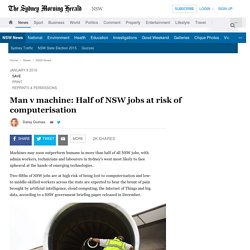
Two-fifths of NSW jobs are at high risk of being lost to computerisation and low- to middle-skilled workers across the state are expected to bear the brunt of pain brought by artificial intelligence, cloud computing, the Internet of Things and big data, according to a NSW government briefing paper released in December. The Future workforce trends in NSW: Emerging technologies and their potential impact report homes in on a sweep of electorates in Sydney's west as being most vulnerable to computerisation, with Auburn, Lakemba, Bankstown, Fairfield, Cabramatta, Liverpool, Macquarie Fields, Campbelltown, Blacktown, Mount Druitt and Londonderry set to lose thousands of jobs to automation in the next 10 to 15 years.
Employment by industry statistics: a quick guide. 14 April 2016 PDF version [322KB] Penny Vandenbroek Statistics and Mapping Section Introduction This guide provides a brief overview of employment by industry and lists some relevant data sources.
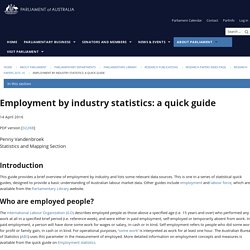
This is one in a series of statistical quick guides, designed to provide a basic understanding of Australian labour market data. Who are employed people? The International Labour Organization (ILO) describes employed people as those above a specified age (i.e. 15 years and over) who performed any work at all in a specified brief period (i.e. reference week), and were either in paid employment, self-employed or temporarily absent from work. Employment-by-industry-2012-13. Industry sector of employment. The Australian Work and Life Index 2014 - National Report. How Good is Part Time work? OECD Emplyment Outlook 2010. Long term unemployment : ABS, 2011. <h4>Please enable javascript to see the dynamic graph content</h4> People who are unemployed for long periods of time may experience economic hardship and be at greater risk of poverty than those unemployed for shorter periods.
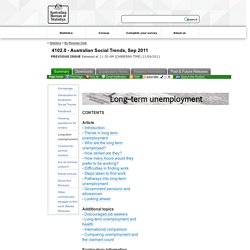
They can also miss out on the networks and social interactions that employment can offer, while low income and lack of access to the job-market can lead to disadvantage and in turn social exclusion. (Endnote 1) Families with members who are unemployed for a year or more (long-term unemployed) may also be negatively affected, and there is concern that this may contribute to intergenerational disadvantage. (Endnote 2) What’s more, the longer people are unemployed, the harder it may become to return to, or gain, employment. Long-term unemployment places a strain on the economy because of people’s reliance on government pensions or allowances. Australia’s unemployment rate peaked soon after the economic downturn of the early 1990s. Family Matters - Issue 33 - What unemployment means. Any society owes its young people the best possible opportunities to assume healthy and positive adult roles, both because the wellbeing of each individual is important in itself, and because of the potential contribution of individuals to the collective wellbeing.
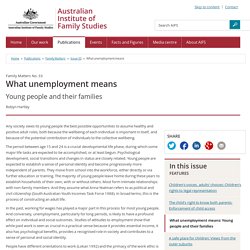
The period between age 15 and 24 is a crucial developmental life phase, during which some major life tasks are expected to be accomplished, or at least begun. Psychological development, social transitions and changes in status are closely related. Young people are expected to establish a sense of personal identity and become progressively more independent of parents. They move from school into the workforce, either directly or via further education or training. Australia's future workforce? On 16 June 2015, CEDA released a major report focused on the future of Australia's workforce.

Download the report: Australia's future workforce? Read media release: CEDA report: More than five million Aussie jobs gone in 10 to 15 years CEDA's major research report for 2015, Australia's future workforce? Are you ready for the jobs of the future? The flow of reports about the impact of automation, mostly dire, continues.
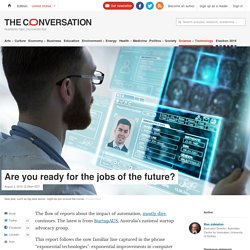
The latest is from StartupAUS, Australia’s national startup advocacy group. This report follows the now familiar line captured in the phrase “exponential technologies”: exponential improvements in computer power and advances in technology such as artificial intelligence, robotics, big data, cloud computing and the internet of things will have a profound impact on future employment, with almost 5 million current jobs (that is 40% of the workforce) in Australia becoming obsolete by 2030. This follows in the footsteps of a detailed CEDA report in 2015, which conducted the modelling used by StartupAUS. Is this doomsday chatter? National employment standards. Introduction The National Employment Standards (NES) are 10 minimum terms and conditions of employment (set out in Part 2-2 of the Fair Work Act 2009) that apply to national workplace relations system employees.
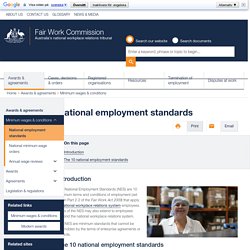
Parts of the NES may also extend to employees beyond the national workplace relations system. The NES are minimum standards that cannot be overridden by the terms of enterprise agreements or awards. History of employment law. 50 years of Labour Force Statistics Now and Then: ABS. <h4>Please enable javascript to see the dynamic graph content</h4> Information on people's experience in the labour market - about when and whether they work, in what sort of jobs and for how many hours a week - is a window into life in Australia.
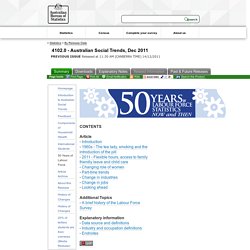
It highlights changes in both our economy and society and the interactions between them. The Australian Bureau of Statistics (ABS) collects this information through its Labour Force Survey (LFS). The LFS is the Bureau's longest running household survey and has provided the basis on which the ABS has built an extensive program of labour and social surveys of the Australian population. Still working for the man? Women’s employment experiences in Australia since 1950. The Glass Ceiling Index. 6202.0 - Labour Force, Australia, Jun 2016. Employment increased 8,300 to 11,933,400.
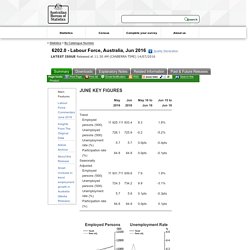
Unemployment decreased 200 to 725,900. Unemployment rate remained steady at 5.7%. Participation rate remained steady at 64.8%. Monthly hours worked in all jobs decreased 0.7 million hours to 1,635.1 million hours. Employment increased 7,900 to 11,939,600. Each year the Monthly hours worked in all jobs series is benchmarked to an annual hours worked level.
The estimates in this publication are based on a sample survey. For further information about these and related statistics, email <client.services@abs.gov.au> or contact the National Information and Referral Service on 1300 135 070. Document Selection These documents will be presented in a new window. Statistics, data and news - Work and Employment Relations - Guides at University of Western Australia. Stats at a Glance. The ABS has revealed that trend employment has grown over the last year, while the number of people with a job has dropped. - BUSY At Work. Australia unemployment and employment statistics. Labour Force Region (SA4) - Unemployment Rate by State and Territory - LMIP. Labour Market Information Portal. Employment Projections Employment is projected to increase in 16 of the 19 broad industries over the five years to November 2020.

Health Care and Social Assistance is projected to make the largest contribution to employment growth (increasing by 250,200), followed by Professional, Scientific and Technical Services (151,200), Education and Training (121,700) and Retail Trade (106,000). Together, these four industries are projected to provide more than half of total employment growth over the five years to November 2020. 2016 Employment Projections Employment projections for the five years to November 2020. Each year, the Department of Employment produces employment projections by industry, occupation, skill level and region for the following five-year period. Industry sector of employment. Employment status. Tomorrow's Digitally Enabled Workforce. Dr. Stefan Hajkowicz The main conclusion we draw from this study is that we’re entering into a period of rapid technology fuelled disruption of labour markets.
Australia Full Time Employment Change. The future of employment in Australia - Ockham's Razor. Despite the fact that traditional sources of employment are disappearing, Australians are expected to work both more productively and for longer. Where will the jobs come from in future? Geoff Hudson suggests an entirely new framework for talking about employment in the 21st century and throws up some blue sky research ideas. Trying to get a job is awful. Australian Jobs publication. The Australian Government Department of Employment. Youth employment in Australia: